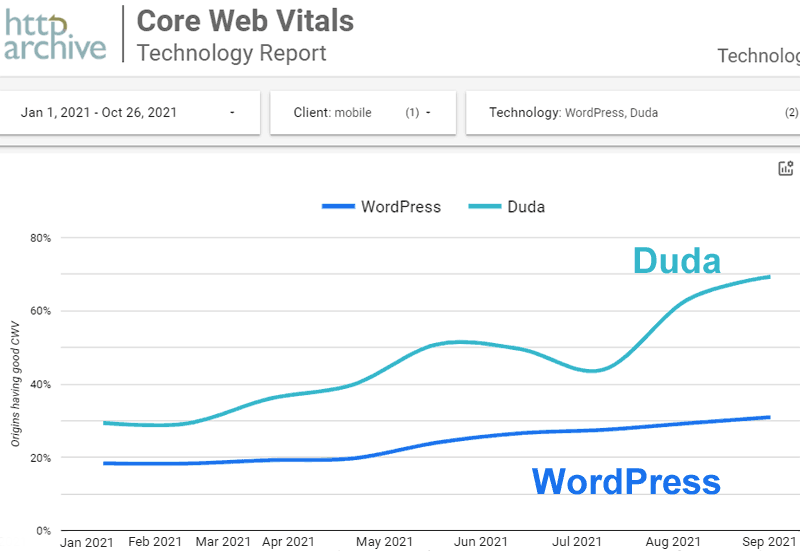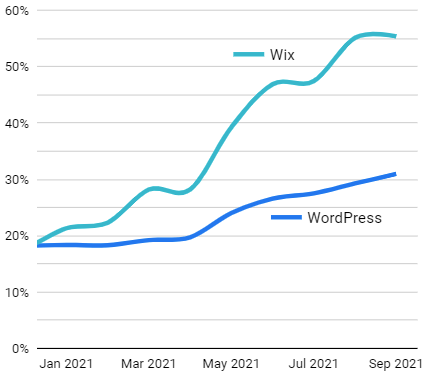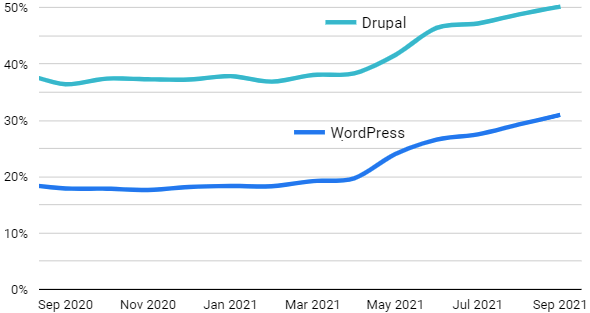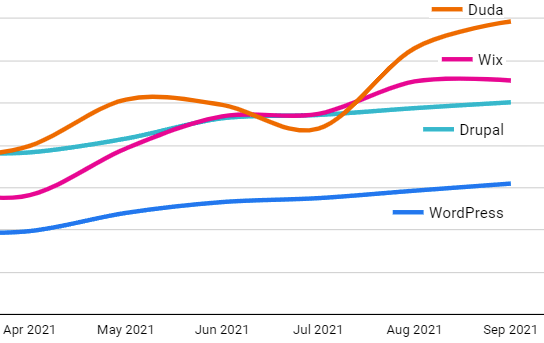HTTPArchive published real-world statistics of Core Web Vitals performance of major CMS platforms that showed many open source and commercial platforms making gains in Core Web Vitals performance. The most dramatic performance gains were the result of proactive initiatives.
Core Web Vitals is a Distraction
Solving Core Web Vitals is important in terms of ranking and not just because it’s a ranking signal at Google.
Fixing problems with themes, plugins and the CMS itself to improve Core Web Vitals is a distraction from the business of doing business and promoting the website itself.
That’s energy, time and money that could otherwise be spent on content and promotion.
This is why this report is important, because it provides an overview Core Web Vitals performance and the direction a given platform is going.
Chosen Platforms for Review
This survey is of arguably the top website builders and content management systems.
There are some website building platforms that were omitted for discussion because they either trail too far behind, have only been scored for a few months or because there weren’t enough websites built with the technology that were scored.
One note, all of the percentages discussed in this article relate to the mobile scores, not desktop scores and not a combined desktop score, just the mobile scores.
Commercial Platforms Show Dramatic CWV Success
It was just a few short years ago that developers and publishers who worked with WordPress routinely dismissed platforms like Wix as behind on SEO and performance metrics.
Those platforms like Wix arguably deserved the lack of respect from the WordPress developer community because the closed commercial platforms focused heavily on the look of the website and not enough on SEO and page speed.
That started to change in 2020 when the build-it-yourself commercial platforms turned their eyes toward improving SEO and page speed performance.
The latest performance statistics from the HTTPArchive Core Web Vitals Technology Report shows commercial platforms like Duda and Wix making dramatic improvements that, as you will read below, has some at WordPress feeling concerned.
Core Web Vitals Technology Report
The Core Web Vitals Technology Report is comprised of two data sets:
- CRuX dataset
- HTTPArchive Lab Web Technology Detections dataset
CRuX Dataset
The Chrome User Experience (CRuX) dataset is collected by real-world Chrome browser users who have opted into sharing anonymous website Core Web Vitals statistics. This is called Field Data because it’s collected from actual users downloading real web pages. It is real and not a simulation as is the case with lab data.
HTTPArchive Lab Web Technology Detections Dataset
With Lab Data, a crawler crawls a website and mobile device and connectivity are simulated in order to calculate Core Web Vital scores.
The HTTPArchive dataset is comprised of lab data derived from crawling millions of URLs that are a part of the CRuX dataset.
According to the HTTPArchive FAQ:
“The HTTP Archive crawls millions of URLs on both desktop and mobile monthly. The URLs come from the Chrome User Experience Report, a dataset of real user performance data of the most popular websites.”
WordPress Performance Versus Duda
The following comparison is year to date scores (meaning from the beginning of 2021) and is made up of sites located in the USA.
Duda is a website building platform for web professionals. Similar to WordPress, it allows significant room for modification to the code. However, Duda maintains control over the underlying technology to ensure high performance.
It’s that control that allows Duda to focus its development team on features that users want, like high page speed performance.
The Core Web Vitals Technology Report shows that strategy paying off.
The percentage of websites that have a good CWV score have risen dramatically just in this year to date, by margins over 100%.
The data shows that 69.3% of websites built with Duda have a good Core Web Vitals score. At the beginning of the year only 29.39% of Duda sites had good scores.
WordPress meanwhile started off the year with only 18.36% of sites built with WordPress displaying good Core Web Vitals scores and the latest scores shows modest gains, with 30.96% of sites scoring well on Core Web Vitals.
While the gains won by WordPress are modestly impressive the final score of 30.96% falls far short of Duda’s score of 69.3%.
Duda Outperforms WordPress in Core Web Vitals

Why is Duda Pulling Ahead?
I asked Duda for information about what accounts for their dramatic score improvement. If you look at the graph it is apparent that Duda has been steadily improving their scores all year long. But sometime this summer the scores rocketed up in a steep curve.
The improved scores, according to Duda was because of data driven approach to collecting data to understand what the problems were and then addressing them.
Here’s what they shared:
“It started by understanding that this is a very important topic for our customers and therefore we assembled a task force with the goal to be the #1 CMS with CWV scores.
We took a very data driven approach. We installed the Google CWV library on all of our sites and sent the collected data to our business intelligence (BI) tool used to visualize data.
Then we had information of CWV performance over time that we could filter according to different parameters like the template type, the account (we have large partners with many thousands of sites on the platform), the geo, site features that were used and more.
Using this data driven approach we were able to identify opportunities for improvements.
We implemented those improvements and checked the improvement again using our BI tool.
This was a successful iterative approach that helped us to increase scores over time.”
Fixing a website building platform that allows developers to add their scripts and widgets is a challenging problem.
Duda solved the problem by working together with their customers.
Cumulative Layout Shift (CLS). is an issue where a web page jumps around as it is downloading. A page that jumps around is a poor user experience because the causes the site visitor to click on an interactive object only to miss it and feel frustrated.
Solving CLS is a top priority for all websites.
This is how Duda improved the CLS scores:
“Heavily used 3rd party apps caused large Cumulative Layout Shifts. We worked with those app developers to optimize their apps
CLS is frequently caused by delayed loading of Google Fonts. We fixed it by inlining the Google fonts necessary for displaying content above the fold.
We discovered that images with no proper width/height attributes were causing CLS. We added relational attributes to any image.
We found out that some partners built custom widgets that are loaded in JavaScript and causing CLS. We worked with those partners to write the widget in the correct way.”
Taking a proactive approach to identifying weak areas and then working together with the customers to fix the problems is how Duda improved their customers Core Web Vitals scores.
Their efforts have obviously paid off.
WordPress Versus Wix
Wix is another closed system that allows businesses to build a web presence and start doing business online fast. All of the technology updates and improvements are handled by Wix which frees their customers to focus on their business.
Like Duda, Wix has also been devoting resources to improving search engine optimization and the Core Web Vitals scores of their customers.
The work they put into fixing Core Web Vitals paid off. The year began with 28.2% of Wix sites earning good CWV scores and the sites are currently at 55.3% of sites scoring well.
Core Web Vitals: WordPress Versus Wix

The Core Web Vitals comparison report shows that Wix and WordPress started out 2021 with virtually equal performance scores. But beginning in January Wix began to pull ahead and by May 2021 Wix was outperforming WordPress by a wide margin.
Dan Shappir, Performance Tech Lead at Wix, explained how Wix has achieved these remarkable scores:
“We have adopted a company-wide, performance-oriented culture. Every feature, component and element that we deliver is built with performance at the core.
Because of this, over the past year we’ve managed to achieve dramatic improvements for Core Web Vitals and have increased the ratio of Wix sites in the Google CrUX report with good scores for all three CWV by 750%.
Performance is a journey, not a destination and we will continue to build upon this momentum to improve performance for our users, and their site visitors.”
Putting performance first at the company-wide level is a good idea so that there is buy-in on performance at every level.
Related: Wix vs WordPress: Which Is Better for SEO?
Open Source is Not Inherently Disadvantaged
Some might say that WordPress has a disadvantage because it is open source and is managed by committee. But that’s not necessarily true.
Drupal, another popular CMS has high Core Web Vitals scores, with over 50% of Drupal websites scoring well for Core Web Vitals.
CWV Comparison of Drupal Versus WordPress

If Drupal can raise their Core Web Vitals scores surely WordPress can get its act together as well?
Core Web Vitals Winners
There is one more web platform that deserves a closer look and that’s Weebly.
Weebly started out in January 2021 as the Core Web Vitals leader with 37.9% of Weebly sites passing with a good Core Web Vitals score. Weebly beat out WordPress, Wix, Duda and Drupal.
However that isn’t the achievement and victory that it appears to be.
The year prior, in January 2020, over 50% of Weebly sites performed well in Core Web Vitals. That means that at the beginning of 2021 Weebly’s score was lower than the year before, 2020. That means Weebly experienced a negative downward trend.
Weebly Core Web Vitals Scores Deteriorated

Nine months later in September 2021 the Weebly Core Web Vitals scores rose by a slight 6% to a 43.3% score.
For September 2021, that put Weebly in fourth place, with a 12 percentage point lead over WordPress.
That puts WordPress dead last in fifth place among the major web content management platforms.
Top 5 Highest Core Web Vitals Scores
As a reminder the percentage scores represent the percentage of sites that had a good Core Web Vitals scores.
Duda is the clear winner in Core Web Vitals. A whopping 69.3% of Duda websites had a good Core Web Vitals score.
Their lead is by a margin of 14 percentage points over the number two ranked platform Wix.
Drupal scored a solid third place, but it is almost 20 percentage points behind Duda.
Duda, Wix, Drupal and WordPress CWV Scores

Top 5 Core Web Vitals Scores
- Duda 69.3%
- Wix 55.3%
- Drupal 50.2%
- Weebly 43.3%
- WordPress 31%
Why is WordPress Falling Behind?
I received an angry email from an anonymous person who objected to an article that reported that WordPress acknowledged it was falling behind.
The thing is, those weren’t my observations. It was WordPress itself saying they were falling behind.
The article was about the observations made by the developers themselves who are responsible for creating WordPress.
WordPress is falling behind and the volunteer developers of WordPress who create it acknowledge the fact that WordPress is falling behind.
That’s a good thing that WordPress acknowledges their failing and is not something to get upset about. A problem cannot be fixed until it is acknowledged that there is a problem.
Creating a team to focus on page speed was the subject of an October proposal to create a WordPress performance team.
The proposal states:
“We (the undersigned) believe that WordPress needs an official Performance team responsible for coordinating efforts to increase the performance (speed) of WordPress.
This proposal outlines why we believe that this is necessary, how we envision such a team might function, and some potential initial areas of focus.”
The developer who wrote the proposal continued:
“Compared to other platforms (e.g., Wix, Shopify, Squarespace), WordPress is falling behind.
Other platforms are on average faster – and becoming increasingly faster – than WordPress websites…”
Perhaps then the reason WordPress is falling behind other platforms is because there is no performance team at WordPress and there is no company-wide performance-oriented culture.
Some of the WordPress volunteers are working on improving WordPress, but the fact is that there is no coordinated effort to improve performance gains.
And that’s why the proposal to create a performance team is such a meaningful step forward for WordPress.
Thierry Muller, Software Engineering Manager at Google, who is also a WordPress core contributor commented:
“The better understand which area are hurting most WordPress sites, we* have conducted analysis on the 100 most popular themes and various real WordPress sites (from small to large).
The results of our analysis are that the largest offenders are Modern image formats, Responsive images followed by JavaScript execution time, Unused JavaScript, Render-blocking resources, Redirects, Long cache TTL.
This analysis (or further analysis based on other criteria) may inform well inform our roadmap. Depending on the number of contributors we will be able to work on multiple projects simultaneously.
By ‘we‘, I mean my team at Google”
Thierry later adds that the project doesn’t have to end at fixing the WordPress core but could also extend to adding performance signals the themes and plugins review checklist.
So the effort to improve WordPress performance could in theory extend to plugin and theme developers.
The problem with all of this is that Core Web Vitals was introduced over two years ago and two years later WordPress is only now getting around to discussing creating a group to tackle performance, much less reach agreement to actually do anything.
Read more about the proposal to improve WordPress performance: WordPress Proposes Team to Improve Core Web Vitals
Web Building Platforms That Win
Not all private platforms are succeeding. But Wix and Duda are standouts that show how private web building platforms can organize to respond rapidly to customer needs.
In the open source market it’s Drupal that is showing how open source projects can succeed.
As of this writing, Duda and Wix are Core Web Vitals champions while in the open source world Drupal is also a winner.
While Duda, Wix and Drupal are winning the race WordPress is just getting started.
At this time WordPress is merely talking about organizing a coherent effort to prioritize performance.
Maybe next year the story will be different for WordPress.
Citations
Learn About the Core Web Vitals Technology Report
Introducing the Core Web Vitals Technology Report
View the Core Web Vitals Technology Report
Core Web Vitals Technology Report
WordPress Acknowledges Performance is Falling Behind
WordPress Proposes Team to Improve Core Web Vitals